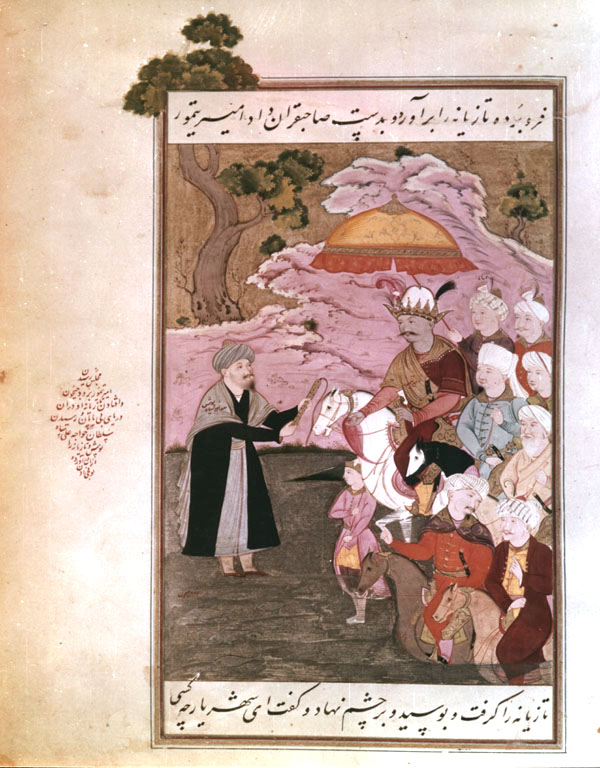Sultan Ḵˇāja ʿAli Siāh Puš Returning Timur's Whip
Sultan Ḵˇāja ʿAli Siāh Puš was, like his illustrious grandfather Ṣafi al-Din (see folio 11), a head mystic. Ḵˇāja ʿAli according to legend met Timur on three separate occasions, both in the flesh and in the form of a likeness between 1381 and 1404. The first encounter was when Timur was crossing the Oxus River enroute to an invasion of Transoxiana and his whip fell in the water. Suddenly an apparition of a darvish appeared before him and returned the whip. The legend can probably be considered a fabrication of later theologians.
The scene depicted in the painting takes place in a river, obviously the Oxus. Sultan Ḵˇāja ʿAli Siāh Puš stands alone on the left, mystically on the water, not in it, and hands the whip to Timur. He is clothed in a gray and black robe, gray shawl, and gray turban. Ḵˇāja ʿAli is austerely dressed, but the representation conflicts with Eskandar Monshi’s description, which states that he was dressed only in rags. The right half of the picture is crammed with overlapping figures, all except one on horseback, and those whose lower extremities are visible are partly submersed in water. Timur is the dominant figure in the group, portrayed slightly larger than the others, dark-skinned like an Indian. The renowned conqueror rides a white horse, and the parasol of kingship is held aloft aver his head by a retainer. Seven mounted followers and attendants form a group around and behind the eminent emir, and a diminutive groom proceeds on foot before him. The water is rendered in silver, now tarnished, and the background is dominated by stylized pink rock formations and two trees rendered in brown and green, the larger of which violates the frame. The parasol is rendered in orange and yellow; the clothing in blue, orange, purple, black and gray.
Location: Reza Abbasi Museum, Tehran, No.77.1.7, folio 13.
Folio size: 35.6 x 21.6 cm. wide (after Mahboubian)
Painting: 23.2 x 14.6 cm. including marginal extensions. (after Mahboubian)
Written surface: 22.5 cm. (scaled) x 13.1 cm. wide. One line of text above and below the painting. Frame encloses painting and text.
Inscriptions: A marginal inscription in red, possibly of later date, describes the event depicted. Inscriptions in the same color and handwriting on the painting identify Timur, Sultan Ḵˇāja ʿAli Siāh Puš, and the river.
Painting references:
Mahboubian_1972, #923 folio 13 (not illustrated).
Text references:
See Muntaẓer-Ṣāḥeb_1970, pp.14-15 for this event in the History of Shah Esmāʿil.
See Savory, SA_1979, p.27 for this event in the History of Shah ʿĀbbās
Savory, Safavids_1980, p.13
Robert Eng
Last Updated: October 3, 2011 | Updated:
November 30, 2010 | Originally published: April 4, 2002
